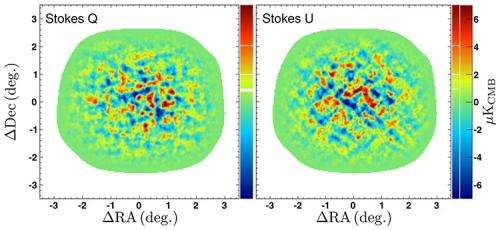October 27, 2014 report
Best of Last Week – POLARBEAR detects oldest light, PhotoMath solves equations and oldest human DNA found

It was another big week for physics as a team of researchers led by Brown University's Vesna Mitrovic found new evidence for an unusual superconducting state—the results of fifty years of research. Also, a team of cosmologists working on project POLARBEAR detected curls in the oldest light in the universe—it represents the most precise and sensitive measurements of the microwave background to date. And a team of researchers at Shanghai University found a unique 1-D metasurface that acts as a polarized beam splitter, allowing a novel form of holography. It's different from 2-D and 3-D methods and offers the possibility of better security when used in anti-counterfeiting holographs.
There was news from Saturns' moon as well; one team found that organic molecules in Titan's atmosphere are intriguingly skewed—they shift away from the poles and are upending traditional thinking about the moons' windy atmosphere. Meanwhile, a team from NASA identified an ice cloud at very hight altitude on Titan. They report that it is very similar to clouds that form above the Earth's poles.
In other news, in a truly unique study, a team of anthropologists were able to unlock clues about Roman gladiators' eating habits—turns out they were mostly vegetarians when training and took in ashes as a tonic. Also, a new phone app, PhotoMath, allows blink, point and shoot equation solving and is likely to stir up interest—it allows a smartphone to solve math problems, which could be used for helping to learn, or in some cases to help students cheat on exams. And researchers with the Salk Institute have identified a promising target for HIV/AIDS treatment—good news for the more than 35 million people around the world currently living with the virus. Also of interest, researchers report unearthing the oldest DNA ever found, shedding light on humans' global trek—from the femur of a man who died beside the banks of a west Siberian river approximately 45,000 years ago.
And finally, if you have been feeling tired lately, it might interest you to know that a team of researchers has found that mental rest and reflection can boost learning—perhaps goofing off sometimes really does help.
© 2014 Phys.org





















